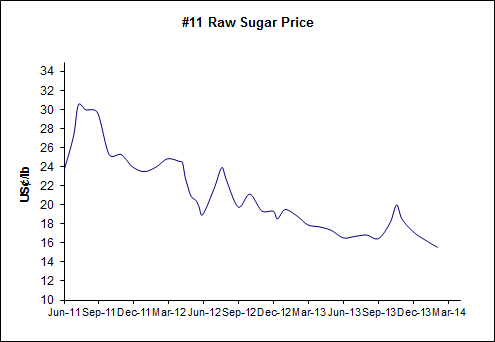February 2014 Welcome to our news page! We try to bring you the latest news and comment on this page but it will always be a better place if you send us your news. You can write to us by clicking on the Contact link at the left. Chrsymas and New year were so quiet that this is the first news page of 2014 : WORLD PRICE Just when we though the price was on the up, it carried on down and closed January at about 15.5 ¢/lb : 
We will have to see what views are expressed at this month's Dubai conference. MOROCCO Shares in Cosumar, the Moroccan sugar company now part owned by Wilmar, were suspended on January 23 and then a week later an offer was made by Wilmar and a consortium of local shareholders to buy the remaining 36% of the company in the hands of the public. Assuming that deal goes through, the consortium will own 91% of the company, the remaining 9% still being held by the King. THE SUDAN The Mashkour sugar project in the Sudan seems to be going ahead, India’s Exim bank having provided a $125 million line of credit. The main contractor is OIA, the Indian consortium which is also the contractor for Ethiopia’s Tendaho project. Production is expected to be 140 000 t/a. ANOTHER NEW FACTORY FOR KENYA? Riana Sugar is reported to be starting a 3500 tcd factory project in the South Nyanza belt on the eastern shores of Lake Victoria. In addition to Sony, there are already two new factories in the area : Sukari and Trans Mara. The factory is supposed to start crushing in October 2015. ZAMBIA SUGAR ZSC has signed a Memorandum of Understanding with the government which should pave the way for a long-term off-take agreement so that ZSC can justify developing an ethanol business. ZSC is talking of launching the project towards the end of this year with erection starting in 2016 and full production in 2017. INDIA An interesting article has emerged from India about its local industry. The conclusion is that there is a disconnect between the price of cane and the price of the products to the extent that all of the millers seems to be making a loss. Translating into US ¢/lb terms, it costs about 26 ¢/lb to make sugar in Uttar Pradesh but the selling price is only 20.5 ¢/lb. Where next for India? FANJULS RETURN TO CUBA An article in the Washington Post has revealed that Alfie Fanjul, the oldest of the four brothers that essentially own ASR, has been visiting Cuba and seems to see an investment opportunity there [or maybe that should be a re-investment opportunity]. JAMAICA Seeing will be believing but the Chinese owners of most of the Jamaican sugar industry are saying that they will be investing US$180 to 200 million in the industry, primarily at frome and Monymusk. Apparently work has already started on agricultural improvements at Monymusk expected to cost between $40 and 50 million. BELIZE The deadlock between BSI and the farmers over payments for bagasse seems to be over with the crop eventually starting towards the end of January. As reported here previously the dispute has been over a demand by the farmers for payment for their bagasse. COPERSUCAR SANTOS Things are slowly returning to normal at Copersucar’s burnt out terminal in the Brazilian port of Santos. It shipped 100 000 tons in January and is expected to ship 250 000 in February so that it should be back to half of its 800 000 monthly capacity by April. FIJI It looks as if Fiji could be the next target for China as ASR pulls out, having given up on its efforts to secure a reliable supply of raws for Thames refinery. The government is talking of China buying 100 000 tons or more each year, paying a similar price to that currently paid by the EU. As Fiji’s exports, according to ISO, dropped from over 300 000 in 2005 to only 80 500 in 2012, it is not clear how the target will be achieved. CYCLONE DYLAN North Queensland was battered by a cyclone called Dylan at the end of January. It must have come ashore somewhere around Townsville but the preliminary assessment is that although there has been some lodging the cane crop has survived. |
